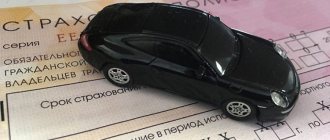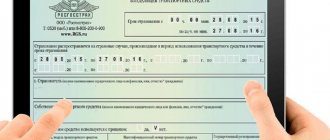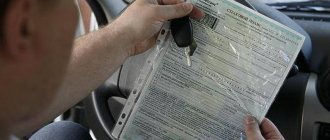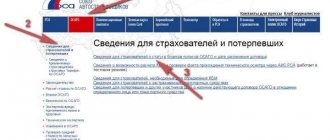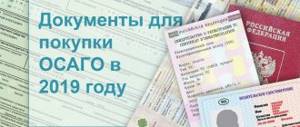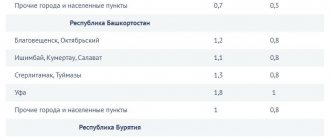The main task of drivers receiving an insurance policy is to find out how the KMB is applied with unlimited insurance (bonus-malus coefficient), and how to use it, what actions to take when applying for an MTPL insurance policy.
Dear readers! The article talks about typical ways to resolve legal issues, but each case is individual. If you want to find out how to solve your particular problem , contact a consultant:
+7 (499) 938-81-90 (Moscow)
+7 (812) 467-32-77 (Saint Petersburg)
8 (800) 301-79-36 (Regions)
APPLICATIONS AND CALLS ARE ACCEPTED 24/7 and 7 days a week.
It's fast and FREE !
Not every driver can correctly answer the question of what KBM classes are. Knowing such details is beneficial; when you sign up for a policy, you can get an additional discount.
Each car owner, along with the standard package of documents for the car, must have a motor vehicle insurance policy - OSAGO. It is mandatory.
Thanks to the MTPL policy, all road users are protected from damage. In the event of an accident, the guilty party compensates the damage to the victim through insurance.
The money received can be spent on restoring the car and on recovery if the accident caused harm to health.
What is KBM in MTPL insurance?
This is a system of insurance coefficients that determine the price of the policy depending on the history of insured events. The name "bonus malus" comes from the Latin words bonus and malus, meaning "good" and "bad." The purpose of the KBM is to increase the interest of road users in careful driving. Accident-free drivers are entitled to a discount; insurance for those at fault will cost more.
In the Russian Federation, KBM was introduced in 2003. The automated system appeared in 2012 (data on all concluded OSAGO contracts is received within 1-3 days). Now, when switching to another insurance company, a certificate of accident-free driving is not required. The insurer independently requests data from the RSA when issuing a policy.
Who is entitled to a discount and when?
Assignment of KBM is carried out on the basis of information on accident rates, which is contained in previous MTPL contracts that ended a year ago. If there is no insurance history, then the coefficient is taken as one.
The class of the driver (car owner) is calculated once during the validity period of the annual policy. This means that if there are payments due to the fault of the owner of the car, then his KBM will be increased when the next contract is drawn up. When concluding a new policy, the discount for careful driving will be taken into account only if the validity of the previous document expired no more than a year ago. At the same time, the value of the bonus-malus coefficient is not affected by the period of operation of the vehicle.
Sometimes, according to the policy, a limited number of people are allowed to drive a car. In this case, the driver who claims the discount must be included in the insurance on the day the document comes into force. If the driver is added to the MTPL after signing the contract, then the KBM for less than a full year is not taken into account next year.
The discount for careful driving is retained when changing the insurer, as well as when extending the validity period of the policy in the company. The car owner has the right to receive a bonus if, by the time the new insurance comes into force, the validity period of the previous OSAGO policy has expired.
How to determine the Bonus-Malus ratio
It’s easy to determine your KBM. It is enough to take the current table of values (last changes made on April 1, 2020) and a current or expired compulsory motor liability insurance policy.
No accidents or accidents
The easiest way to determine KBM. No table needed. We take the policy, opposite our last name or in paragraph 7 we find our KBM and subtract 0.5 from the indicated value.
After an accident
If the driver is found to be at fault for an accident, then the CBM will be affected by the number of incidents during the insurance year (from April 1 to March 31). To determine the KBM, look for your class in the table (indicated in the policy opposite the last name or in paragraph 7). In the column with the number of accidents, select the appropriate number. At the intersection there will be the desired value.
Where is KBM indicated in the MTPL policy?
The legislation does not provide for mandatory indication of the applied bonus-malus coefficient in MTPL policies. But sometimes insurance organizations issue internal orders in which they oblige employees to indicate the available coefficient next to the name of each vehicle owner. This is especially often done if a large number of people are allowed to operate the machine. The information is entered in the “Special Notes” column.
It should be noted that the driver’s KBM and calculated KBM must be indicated when filling out an application for insurance, which is filled out for the purpose of concluding or extending a compulsory motor liability insurance policy.
Calculation of KBM for unlimited insurance
With limited insurance, the BMI of all admitted drivers is taken into account. To calculate the cost of the policy, the BMI of the driver with the worst insurance class is used. For example, they plan to include drivers of class 5 (KBM 0.9) and class 2 (KBM 1.4) into the policy. For calculation, take the value 1.4.
With insurance without restrictions , the class within the KBM system is assigned only to the owner of the car. The class is determined by the last expired insurance contract. If any driver who gets behind the wheel of the car specified in the policy causes an accident, the owner’s MBI will worsen.
If the previous policy was without restrictions, and the new insurance was with restrictions, then in the absence of payments for the previous year, the insurer is obliged to assign a lower CBM. But only on condition that the owner and the policyholder are the same.
Main aspects
The Union of Automobile Insurers of Russia introduced a coefficient - KBM, which is necessary when calculating the cost of a policy, taking into account the accidents in which the driver was involved.
Taking into account the fact that the cost of compulsory motor liability insurance regularly increases, the KBM coefficient allows many drivers not to go broke on insurance.
Provided that the driver has not been in a serious accident, the cost of insurance can be reduced by up to 50%.
The downside is that drivers who are involved in an accident and pay the damages from the insurance company pay 2.5 times more, taking into account the BMI when switching from unlimited to limited insurance.
What it is
KBM is a coefficient awarded to the driver for driving without accidents. This indicator is decisive when calculating the cost of an MTPL policy.
The coefficient was introduced in 2003 and is actively used to this day by all insurance companies.
There are two types of CBM - increasing, which is accrued in the presence of accidents, and decreasing, which reduces the cost of the policy in the absence of accidents.
The coefficient remains the same even if the driver switches to another insurance company.
The cost of an MTPL policy consists of a single (basic) tariff, which can later be increased or decreased.
The base rate depends on several factors:
- Vehicle power.
- Driving experience.
- Driver's age.
- Region of residence.
Insurers urge drivers to avoid accidents because otherwise the bonus-malus ratio will increase. Thus, a driver can take out an MTPL policy at a discount if he drives for a year without an accident.
Why is it needed?
Most drivers want to know whether they are entitled to a discount based on length of service or other parameters when taking out an insurance policy.
There really is such a discount - its size is affected by the KBM indicator. The driver receives the benefit only under one condition - accident-free driving.
In the case of KBM with unlimited insurance, the law establishes that various factors are taken into account when setting the cost of the policy.
In addition to accident-free performance, the bonus-malus coefficient is influenced by the driving experience of the car. The MSC was introduced to reduce the number of accidents on the roads.
Drivers receive a kind of incentive in the form of a discount on compulsory motor insurance. For most drivers, the cost of the policy is excessively high, and only KBM makes it acceptable.
For every year of driving without accidents, a 5% discount on the total cost of compulsory motor insurance is awarded. If, on the contrary, the driver has an accident, the discount is canceled or reduced upon renewal. However, this only happens if the accident was caused by the driver.
Current legal framework
Regulatory acts applied by Rosgosstrakh and other insurers when issuing compulsory motor liability insurance and calculating the CBM:
| Law on OSAGO No. 40 | The rules for using KBM and the features of calculations are indicated. |
| Decree of the Government of the Russian Federation No. 1090 | Setting the rules of the road |
| RSA Resolution No. 10 | Rules for calculating KBM have been approved |
Car drivers must know all the regulations in order to know exactly what KBM they should be accrued.
Class at the beginning of the annual insurance
Every year on April 1, the KBM is recalculated. The new insurance class depends on your driving history over the last 12 months. Accident-free drivers are given a discount, and an increasing factor is applied to those responsible for road incidents.
It is important to understand that early termination of a break-even contract (even a day or an hour before expiration) takes away the discount accumulated over the period from the driver. When purchasing a new policy, the insurer will apply the same BMR as at the beginning of the early closed contract.
If there is a break in insurance for more than 12 months, the accumulated discount is no longer reset.
The increasing coefficient does not reset to zero during a long break. The history of insurance events is stored in RSA.
What KBM does a novice driver have?
0 34919 In order to purchase a policy at a discount, you need to drive without accidents.
Drivers are interested in what KBM a novice driver in Russia has in 2021, and how this figure will increase in the future or... — Read more —
Driver classes in the KBM table
There are 15 classes in the OSAGO system (M, 0 and from 1 to 13). Each class has a coefficient depending on the number of accidents at the end of the insurance year. Class 13 is considered the highest (can be achieved after 10 years of accident-free driving). The lowest class is M, insurance for such drivers is the most expensive. It is easy to get into class M even with one accident in which the driver was found guilty (it all depends on the class in force at the time of purchasing the policy). For example, a driver with class 13 gets into 7 for one accident. And a driver of class 6 gets into 4 for a single accident.
The current class is indicated in the policy opposite the driver’s full name and in paragraph 7 , which lists all the coefficients used in the calculation.
How to determine KBM if several people are included in the compulsory motor liability insurance?
If several motorists are indicated in the OSAGO, then the bonus-malus coefficient is calculated according to the following rule: the largest indicator is taken into account. For example, two drivers have accumulated a discount of 40% (their BMR is 0.6), and a third person has a discount of 10% (0.9), then the cost of compulsory motor liability insurance is calculated using a 10% discount. If one of the insured drivers gets into an accident and is found guilty of what happened, then his coefficient will only increase. For the rest, the discount increases by 5% per year. In the case where the compulsory motor liability insurance policy requires admission to driving a car for an unlimited number of people, then the discount assigned to the car owner is taken into account.
How does the OSAGO class affect the discount?
Upon first insurance (the policy is purchased for the first time), class 3 is automatically assigned (with KBM = 1). Since there is no insurance history, there is nothing to reward or punish for. In the future, with trouble-free driving, the BMR is reduced annually by 0.5 units, the discount gradually increases. If a driver is found to be at fault for an accident, an increasing factor is applied. The amount depends on the number of incidents per year (only those for which the policyholder is at fault are taken into account). For example, the owner of the policy was involved in 5 accidents and was found guilty in two cases. They will be punished, respectively, for 2 accidents.
Please note that the insurance year lasts from April 1 to March 31.
FAQ
In order for the KBM to be understandable to the driver, he must understand some of the nuances. So, it is very important to understand what to do if the KBM indicator does not correspond to what it should be in reality. It would also be nice to understand how the indicator in the RGS increases and what affects its level. And naturally, drivers may ask questions related to which class is the minimum. Video: what you need to know about KBM
What actions to take if this value is not true
If, when applying for regular insurance, the driver discovers that the wrong class was used in the calculations, then he must figure it out and restore it.
The first thing to understand is that there are legitimate reasons for the change. If the driver has no accidents due to his fault, he has not changed his license, has not purchased a new car or type of insurance, and has not taken a year off, then a reduction in the bonus is unacceptable.
In case of reset or when the BMR remains at the same level, you should first contact the insurance company, providing old policies with the specified BMR, a certificate of accident-free status, as well as a driver’s license and citizen’s passport. After checking all the documents, insurers will most likely return the BMR to the real level. But if a refusal is received or there is no response within a month, you should write a complaint to the RSA and the Central Bank of Russia.
These authorities can help and resolve the situation if there were indeed violations on the part of the company and, for example, Ingosstrakh did not carry out restoration.
How does the indicator increase (change)
The bonus-malus class changes every year, depending on whether the driver had an accident or did not have one.
To increase the indicator, you should avoid accidents due to your own fault, that is, drive carefully and follow the rules.
There is no other way to increase the KBM, and all that remains is to follow the instructions prescribed by law. It can be reduced for accidents caused by the driver. For example, when asked what KBM 0.95 means, you can answer that the person using it started with the standard class and spent a whole year without an accident.
What influences its meaning
As mentioned earlier, the bonus-malus class that is assigned to the driver is affected only by the accident rate during the year. The length of service, age and characteristics of the car have absolutely no meaning when calculating the KBM, since this indicator reflects the reliability of the driver in principle. Therefore, if the driver has not had an accident, then his indicator will remain unchanged and will only increase, for example, in a year without accidents, class 7 will increase to class 8.
What is considered the minimum value?
The minimum possible class is M, which assumes that when calculating the price of compulsory motor insurance, a coefficient of 2.45 is applied.
At the same time, with a certain number of accidents, a large number of people can be reduced to class M. So, in case of one accident, owners of classes 0 and 1 can automatically reduce to the minimum value, in case of two - owners of classes 0-3. Three accidents can reduce classes 0-8 to a minimum, and four or more accidents can reduce absolutely any class to M, even with a coefficient of 0.55.
Find out how to correctly fill out an application for the restoration of the KBM in the RSA from the article: application for the restoration of the KBM. If you want to know how to change the class of motor vehicle insurance according to OSAGO, read here. If you are interested in the question of how the BMR is calculated, see here.
CBM is widely used in the insurance industry as a means of reducing company risks in relation to unreliable drivers, as well as a way to discipline them. The bonus-malus class gives the driver both the right to a discount on the policy and can increase its price if we are talking about a negative class. To increase it, you just need to avoid accidents, then the cost of insurance will decrease every year, but with the slightest accident it can increase again significantly.
Restoration of KBM
To restore the KBM, you need to write a letter to the insurer. The following information must be provided:
- passport details of the policyholder;
- series and number of rights (current and previous);
- information about the insurance contract;
- the essence of the problem.
The application can be filled out by hand or on a computer by downloading the form on the Internet. If the insurer does not respond to the appeal, then it is advisable to file a complaint with the RSA (consideration period is 3-4 months), the Prosecutor's Office and the Central Bank of the Russian Federation.
Expert opinion
Ivan Strahovsky
Insurance expert
OSAGO calculator
Review results may vary. The KBM may be left unchanged, lowered (the error will be corrected) or increased. The latter is possible with unlimited insurance (the other driver was found to be at fault). The vehicle owner's KBM will deteriorate.
Is it possible to return KBM under insurance?
If you have any doubts about the discount that the database issued, then to clarify the circumstances you need to write an application to the head office of the RSA.
If the contract has already been concluded without taking into account the discount, then the application is filled out according to the sample ().
If you are sure that your discount has not been saved in the RSA database, then the application can be filled out according to the sample ().
RSA receives complaints related to issues of unfair application of discounts.
AIS RSA database
In 2013, from 01.01, an automated information system was put into operation, the functions of which are to take into account coefficients for compulsory motor liability insurance. The AIS RSA contains data on all signed insurance contracts (since 01/01/2011), owners and owners of vehicles, and accidents they committed. When drawing up each contract, the insurance company is obliged to use a certain “Malus-Bonus” from a single database. In the case when the required information is not present in the AIS RSA, then “Bonus-Malus” should be applied, equal to 1.
Table of insurance classes and discounts for accident-free driving and safe driving
The updated class table includes a column with discount percentages or increasing coefficients. To independently determine the size of the discount, you will need the current class at the time of concluding the contract and the number of accidents per year.
| Class | KBM | Increase in price – Discount | Number of insured events (insurance payments) that occurred during the period of validity of previous MTPL contracts | ||||
| 0 | 1 | 2 | 3 | 4 | |||
| Class to be assigned | |||||||
| M | 2,45 | 145% | 0 | M | M | M | M |
| 0 | 2,3 | 130% | 1 | M | M | M | M |
| 1 | 1,55 | 55% | 2 | M | M | M | M |
| 2 | 1,4 | 40% | 3 | 1 | M | M | M |
| 3 | 1 | No | 4 | 1 | M | M | M |
| 4 | 0,95 | 5% | 5 | 2 | 1 | M | M |
| 5 | 0,9 | 10% | 6 | 3 | 1 | M | M |
| 6 | 0,85 | 15% | 7 | 4 | 2 | M | M |
| 7 | 0,8 | 20% | 8 | 4 | 2 | M | M |
| 8 | 0,75 | 25% | 9 | 5 | 2 | M | M |
| 9 | 0,7 | 30% | 10 | 5 | 2 | 1 | M |
| 10 | 0,65 | 35% | 11 | 6 | 3 | 1 | M |
| 11 | 0,6 | 40% | 12 | 6 | 3 | 1 | M |
| 12 | 0,55 | 45% | 13 | 6 | 3 | 1 | M |
| 13 | 0,5 | 50% | 13 | 7 | 3 | 1 | M |
The federal law on compulsory motor liability insurance can be found in this article.
Formulas for calculating the KBM, how all the coefficients are deciphered in it
If a car owner needs to find out what kind of insurance policy he has for the next year, he should first of all take into account the following nuances. The maximum bonus-malus coefficient according to the law is 0.5, and this refers to the thirteenth class. If the driver did not have any accidents during his trips, then he has the opportunity to purchase compulsory motor insurance at a discount of as much as 50%. It should be noted that it is not difficult to find out whether there have been accidents. All data on whether traffic accidents occurred due to the fault of absolutely any driver is entered into an automated system operated by RSA (Russian Auto Insurance Union).
In addition to the above, the same database also contains information on all MTPL agreements. RSA representatives also emphasize that they do not enter any data themselves - they are entered directly by insurance companies that are obliged to do this. If for some reason there is still no data about the driver’s motor vehicle insurance in the specified database, a claim must be filed with the insurers with whom the citizen previously took out compulsory motor liability insurance. Nowadays, insurance companies use the following terms:
- Driver's KBM - that is, coefficients calculated separately for each person using a particular car.
- The car owner's KBM is a coefficient that is determined directly for the owner of the vehicle.
- Calculated KBM - indicators necessary to determine the amount of the premium (they are calculated depending on the compulsory motor liability insurance agreement).
The class of drivers and owners, note, should always be calculated only once during the entire period of validity of the annual insurance. When paying out due to the fault of the insured KBM, more is made, and this figure increases only when a new policy is issued. Its cost is determined by the discount and does not depend on whether the policy is renewed with the current company or the client decides to turn to other insurers. So, to calculate the price for compulsory motor liability insurance, taking into account the bonus-malus coefficient, use the following formula:
T = TB x KT x KBM x KVS x KO x KM x KS x KN x KP
It deciphers like this:
- TB - “basic tariff”, that is, the basic tariff for the policy, the initial price.
- CT - “territorial coefficient”, i.e. the value of the territorial insurance coefficient.
- KVS - “driver experience coefficient”, everything is clear from the name itself, the time and experience of the driver behind the wheel.
- KO - “limiting coefficient”. Namely, here we are talking about a restriction on the number of drivers of a car.
- KM - “power coefficient”, everything is also clear.
- KS is a “term coefficient”, that is, for the period of time that the vehicle was operated.
- KN - “coefficient for violations,” i.e., the number of violations that occurred.
- CP means the duration of the contract.
Taking into account the understanding and calculation of all the indicators above, the final cost for the entire insurance policy is determined.
Why is KBM needed?
All insurance companies, when calculating the cost of an MTPL insurance policy, must use the KBM in the calculation formula. The size of the CBM depends on a number of factors that must be taken into account in each specific case. It matters how long the client’s driving experience is, as well as how accident-free his driving is.
Why is the policy price calculated this way? Because companies are interested in insuring careful drivers who get into accidents only in exceptional circumstances. The company is always ready to meet such a driver halfway and reduce the cost of the policy due to a more loyal KBM. In other words, KBM is a discount under compulsory motor liability insurance that the insurance company gives to a careful driver with good experience.
Request a call back
Each year of accident-free driving counts towards a 5% discount on the cost of the policy. And if during the year of insurance the client still gets into an accident, then the amount of his discount is automatically canceled or reduced, and next year the MTPL policy will cost him significantly more. But the discount is canceled only when an accident occurs due to the client’s fault. If the other party is at fault or when the incident was not recorded by the traffic police, the client retains the discount. This happens for a simple reason: the insurance company, with its policy, insures the liability of the motorist, and not all theoretically possible situations in which the car may get into. When the driver is not responsible for the accident, this does not affect the future value of his OSAGO policy.
How to find out your KBM under OSAGO using the RSA database?
You can find out your KBM at any time. To do this, you just need to go to the website of the Russian Union of Auto Insurers and enter your data. The fact is that in Russia there is already a database where all holders of domestic driver’s licenses are entered and each of them is assigned the appropriate class. Therefore, to obtain a KBM on the website, you just need to indicate your last name, first name, patronymic, date of birth and driver’s license number.
Once the information is processed, all data relating to the insurance history of the person in whose name the request is made will become available. It should be noted, however, that simply finding out your class is not enough to find out exactly how much you will have to pay for your next MTPL insurance policy. To do this, you should take into account your current KBM and accident rate.
How to calculate KBM
0 5504 In the Russian insurance industry, there is a value assigned to the driver for accident-free driving.
It is called the bonus-malus class and can be used to reduce the risks of insurance companies regarding... — Read more —
With unlimited compulsory motor insurance
When an unlimited number of drivers are allowed to drive a vehicle, only the owner of this vehicle receives a class.
Until 2021, the CBM, in turn, is calculated based on the last completed MTPL agreement. However, in 2021, changes to the procedure for determining the BSC began to take effect. Now it will be determined for everyone on April 1 of every year. In this case, the insurance history will not be interrupted, even if there were interruptions in insurance, as was the case before. All contracts that are still valid as of 04/01/2019 and those that ended no more than one year ago will be taken into account. Based on the collected data, each participant in the compulsory insurance system will be assigned its own CBM class. All MTPL agreements that the client wants to issue after 04/01/2019 will be calculated on the basis of the coefficient value determined in this way; it will be revised no earlier than April 1 of the next year. From 2021, the CBM will be determined once a year on April 1st.
For legal entities, the KBM will be the same for all equipment, the terms for its assignment are the same as for individuals, but the value will be determined as a weighted average of the total amount of equipment owned by one company.
